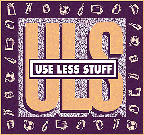Use Less Stuff!
from the ULS Reports...
THE PAPER CHASE
It may be time for spring cleaning, but
there's a blizzard out there! Of paper, that is. The rise of the
service economy over the last 35 or so years has given rise to the
paper economy. Both were aided by a revolution in widely used office
equipment -- computers, printers, copiers and fax machines. And now,
with the proliferation of home offices and home computers (and kids
using computers at home and school), the same forces are also creating
masses of paper clutter and waste where we live.
Today, office paper and related business materials (brochures, flyers,
newsletters, pamphlets, catalogs, etc.) represent the largest source
of non-durable solid waste -- bigger than such typically vilified
items as disposable diapers or plastic packaging. For perspective, the
volume of office paper and commercial printing increased a whopping
245% between 1960 and 1994, from 3.9 to 13.5 million tons. During this
time, all other solid municipal waste generated was up much less --
about 133% (which is still a lot!).
And even though much of this paper is high quality and easily
recycled, we're printing, faxing, copying and collating memos at a
much faster rate than can be dealt with by recycling programs.
Whatever happened to the so-called paperless society?
Time to Use Less Stuff!
In fact, by creating a system that follows the three R's, it's
possible to eliminate virtually ALL paper waste. We estimate that
since starting our program, paper waste has been reduced an amazing
99%! Here's what you can do:
Reduce
Share electronic files, voice mail and e-mail with associates, rather
than paper memos. Save what you need to electronically; use hard
copies only when really necessary.
Scan documents into the computer and transfer information by disk or
intra-office network.
If you must send paper to more than one person, attach a routing slip
and pass along as necessary. Do the same with newspaper and magazine
subscriptions.
If your company has electronic funds transfer (EFT) for payroll, sign
up for it. Have suppliers and vendors arrange for EFT between your
firm and theirs.
Reduce fax traffic by switching to fax modems. You can send and
receive faxes on your computer and view them on-screen. For those
worth saving, do so electronically.
Try to skip cover sheets when sending faxes. Most letters and memos
already include the name of the receiver, and your fax machine
probably stamps your name and phone number on the top of each page.
Subscribe to online rather than paper news services.
Reduce the amount of paper that is easily available in the supply
closet. Psychologically, when people see ream upon ream, they think
that paper is plentiful and cheap. But when they see less and are led
to believe that there isn't any more, or that additional quantities
will cost more and be charged to their budget, paper consumption will
drop dramatically! (Ditto for pencils, pens, clips, rubber bands,
etc.)
Reduce the weight of the paper used in your printers, copiers, and fax
machines. Given how much paper the typical office uses in a year, even
a few ounces saved per ream adds up quickly.
Photocopy on both sides of the paper. The extra few seconds it takes
to push the "duplex" -- or double sided -- button on the machine can
help cut copy paper usage by almost as much as 50%.
Reduce catalog clutter and third class mailings by calling the 800
number of the catalog and asking to be removed from their list, or put
on a reduced list, if available. Call the Mail Preference Service for
their direct mail reduction kit at 212-768-7277.
Reuse
Flip faxes over and use the paper again. If you want your faxes
printed, get a "plain paper" versus a "thermal" fax. The thermal paper
is harder to write on, discolors, and can't be reused or recycled.
Collate old single-sided memos, faxes, etc. into piles, with the
printed side face down. Separate them into piles of about 25 sheets.
Staple each pile four times along the edge of one of the two longer
sides. Use the paper cutter to divide the stapled pile into two
stapled sections, creating 5.5" x 8.5" scratch pads.
When all the name and address spaces on mail envelopes have been
filled in, tape a blank piece of paper to the envelope and label with
two columns, one for name and the other for address. Voila! The
envelope can be used again and again!
Keep a large plastic bag next to the shredder, and fill it when the
shredder basket becomes full. Use this material for packing and
cushioning, eliminating the need to purchase "peanuts."
The ULS Report
 The
ULS Report, Use Less Stuff, Reduction Roundup, and the
ULS logo are trademarks of
Robert Lilienfeld . The
ULS Report, Use Less Stuff, Reduction Roundup, and the
ULS logo are trademarks of
Robert Lilienfeld .
|

